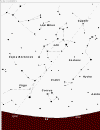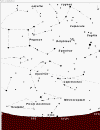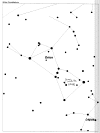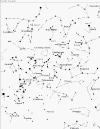|
Paper Plate Education
"Serving the Universe on a Paper
Plate"
Star Charts
|

Click image to enlarge Winter star chart.
Winter Stars, January 15th around 9:30 p.m. as seen from
Cleveland, OH. The dashed line represents the ecliptic, the path on which
an observer finds the sun, moon, and planets. The planet Jupiter is in
Gemini and Saturn is in Taurus in this 2002 sky view.
Following the three belt stars of Orion the Hunter upward and to
the right leads to Taurus the Bull with its prominent red eye Aldebaran, and
beyond that the Seven Sisters of the Pleiades star cluster. Following the
three belt stars of Orion the Hunter downward and to the left leads to the
brightest sky in the night sky, Sirius, in the constellation of Canis Major, the
great dog.
The Gemini twins, Castor and Pollux, straddle the ecliptic,
making Gemini a constellation of the zodiac.
|
|

Click image to enlarge Spring star chart.
Spring Stars, April 15th around 9:30 p.m. as seen from Cleveland,
OH. The dashed line represents the ecliptic, the path on which an observer
finds the sun, moon, and planets.
Leo the lion is rising, its shape defined by a backwards
question mark for the front part of his body and a triangle making up its hind
quarters. Also on the ecliptic, this planet is the domain of the sun,
moon, and planets.
|
|

Click image to enlarge Summer star chart.
Summer Stars, July 15th around 9:30 p.m. as seen from Cleveland,
OH. The dashed line represents the ecliptic, the path on which an observer
finds the sun, moon, and planets.
While technically a constellation of the zodiac in modern times,
the obscure Ophiuchus dominates the summer sky. More popular and obvious
is lethal Scorpius the scorpion. Sagittarius, recognized as a teapot
shape, also sits low on the southern horizon. Toward this direction lies
the center of the Milky Way galaxy. Beginning to emerge on the scene are
Aquilla, Lyra, and Cygnus, whose three brightest stars (Altair, Vega, and Deneb,
respectively) make the Summer Triangle asterism.
|
|

Click image to enlarge Fall star chart.
Fall Stars, October 15th around 9:30 p.m. as seen from
Cleveland, OH. The dashed line represents the ecliptic, the path on which
an observer finds the sun, moon, and planets. As the Summer Triangle
passes high overhead, the Great Square that makes up the body of the upside down
Pegasus the flying horse appears in the southeast. Trailing the Summer
Triangle is a small but distinct Delphinus, looking like a small kite in the
night sky.
|
|

Click image to enlarge Orion star chart.
Orion the Hunter. The Orion Nebula (M43) is
site of a stellar nursery, where stars are evolving out of a cloud of gas and
dust.
|
|

Click image to enlarge Taurus star chart.
Taurus the Bull. The Crab
Nebula (M1) is site of a supernova explosion, where a star experienced a
cataclysmic death.
|

Click image to enlarge North
Circumpolar star chart.
North Circumpolar Stars. The
north circumpolar stars encircle the north pole and are visible
year-round. See the Platisphere
activity to predict the changing position of these stars.
|
 |
 |
North Circumpolar Stars
2002 March 22 at 9:00 p.m.
(Indiana Science Olympics state finals) |
Planets toward western
horizon
2002 March 22 at 9:00 p.m.
(Indiana Science Olympics state finals) |
|
|

Click image to enlarge Perseus-centered star chart.
Perseid Meteor Shower. Enjoy an
August night watching meteors. Plot the streaks of light on a paper
plate starfield to reveal the namesake radiant of the Perseid meteor
shower. See the Meteor Shower
activity to enhance your stargazing. |
| Heavens-Above material used with permission. |
Date/Time (Local Time)
|
|